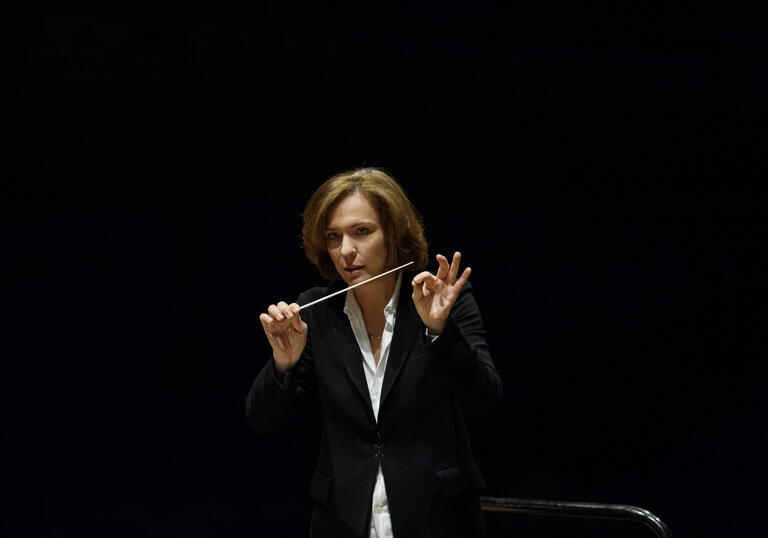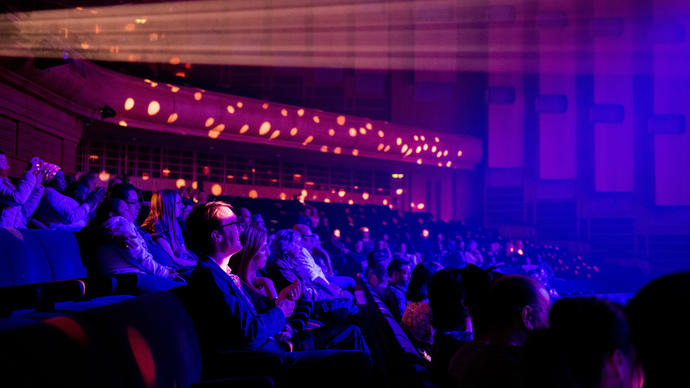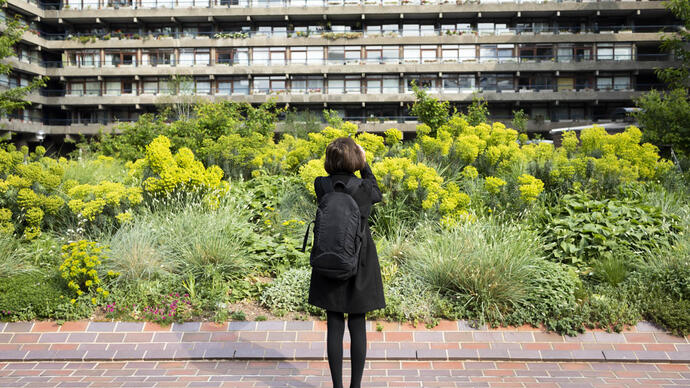
Programme and performers
Charles Gounod Saint François d’Assise
Part 1, La cellule
Part 2, La mort
Gabriel Fauré Requiem
1. Introit
2. Kyrie
3. Offertoire
4. Sanctus
5. Pie Jesu
6. Agnus Dei
7. Libera me
8. In paradisum
Insula orchestra
Laurence Equilbey conductor
Oliver Barlow treble (Trinity Boys Choir)
John Brancy baritone
Amitai Pati tenor
Mat Collishaw filmmaker
accentus
Christophe Grapperon accentus associate conductor
Translations
Part 1: La cellule
St Francis
Mon sauveur adoré,
Seul amour de ma vie
Tout ce qui n’est pas toi
N’est plus rien pour mon coeur.
Ton mystère m’enivre
Et mon âme ravive,
Allume en tous mes sens
Une ineffable ardeur.
Tout ce qui n’est pas toi
N’est plus rien pour mon coeur.
Agneau de Dieu!
Sainte victime!
En toi, Jésus,
Mon coeur s’abîme!
De ton amour embrase-moi!
Tu meurs pour moi!
Je vis par toi!
De ton amour embrase-moi!
Comme le cerf soupire
Après l’eau des fontaines,
Ainsi mon âme a soif de toi, Seigneur!
C’est ton sang adoré
Qui coule dans mes veines
Et m’enivre déjà du céleste bonheur!
The Crucifix
Viens! viens, amant de ma croix!
Viens! ma douce victime!
En attendant la mort qui comblera tes voeux,
De mon amour pour toi
Touche, un instant, la cime, et vois,
Vois que, plus que toi, je veux ce que tu veux!
St Francis
Un miracle! Jésus!
Et jusqu’à cet excès!
Je ne suis plus à moi!
Je t’adore … Et me tais!
Part 2: The death of St Francis
St Francis
Mes enfants! … L’heure approche …
Au séjour des élus,
Je vais donc voir, enfin, le doux Sauveur, Jésus!
Mais, avant que d’entrer dans la terre promise,
Une dernière fois je veux bénir Assise!
Chorus of Men
Père qui régnez dans les cieux!
Ô Dieu d’amour! Dieu de miséricorde!
Que votre grâce nous accorde
Ce qu’implorent de vous les larmes de nos yeux!
Par pitié pour notre misère
Par les clous vénérés de ses pieds, de ses mains,
Ne rappelez pas notre père,
Ne nous laissez pas orphelins!
St Francis
Mes fils! Ne pleurez pas!
C’est le jour qui commence!
La lumière bientôt va dissiper la nuit! …
C’est la fin de l’exil, du deuil,
De la souffrance, mes fils!
Ne pleurez pas!
C’est la mort qui s’enfuit!
(He dies)
Chorus of angels
Prends ton vol vers les cieux,
Bienheureux Séraphique!
De la terre pour toi les liens sont rompus!
Viens chanter pour toujours le céleste cantique!
Entre dans la paix des élus!
Charles Gounod (1818–93)
Part 1: The cell
St Francis
My adored Saviour,
Sole love of my life,
All that is not Thee
Is henceforth as nothing for my heart.
Thy mystery enraptures me
And revives my soul,
Kindling in all my senses
An ineffable fervour.
All that is not Thee
Is henceforth as nothing for my heart.
Lamb of God!
Sacred Victim!
In thee, Jesus,
My heart is engulfed!
Inflame me with thy love!
Thou dost die for me!
I live through thee!
Inflame me with thy love!
Like as the hart
Desireth the water-brooks,
So longeth my soul after thee, O Lord!
It is thy beloved blood
That flows in my veins
And already intoxicates me with heavenly bliss!
The Crucifix
Come, come, lover of my Cross!
Come, my gentle victim!
As you await the death that will fulfil all your desires,
Touch, for an instant, the pinnacle
Of my love for you, and see,
See that, more than yourself, I desire what you desire!
St Francis
A miracle! Jesus!
And a supreme one!
I am no longer mine!
I adore thee – and am silent!
Part 2: The death of St Francis
St Francis
My children! The hour draws nigh.
In the abode of the chosen
I shall at last see the sweet Saviour, Jesus!
But before I enter the promised land,
For the last time I wish to bless Assisi!
Chorus of Men
Father who dost reign in the heavens!
O God of love! God of mercy!
May thy grace grant us
What the tears of our eyes implore of thee!
In pity for our misery,
By the venerated stigmata of his feet and hands,
Do not call our father to Thee,
Do not leave us orphans!
St Francis
My sons! Do not weep!
It is day that dawns!
Soon the light will dispel the darkness!
It is the end of exile, of mourning,
Of suffering, my sons!
Do not weep!
It is death that flees away!
(He dies)
Chorus of angels
Take flight towards the heavens,
Blessed seraphic Father!
For you the bonds of earth are broken!
Come and sing the celestial hymn for evermore!
Enter the peace of the chosen!
Translation © Charles Johnston
Artist biographies
Insula orchestra’s purpose is to present music from the Baroque, Classical and pre-Romantic eras in a historically informed way. Side-by-side with masterpieces of the repertoire, the orchestra also features rarer pieces, such as the music of Louise Farrenc and Emilie Mayer. The ensemble performs on period instruments to match as closely as possible the sound and balance of the original score.
Insula orchestra was founded in 2012 by its Artistic Director and conductor Laurence Equilbey. In 2017 Insula inaugurated La Seine Musicale venue as its resident orchestra. The ensemble performs part of the Auditorium’s season, alongside numerous other ensembles and artists. Insula orchestra also regularly performs at leading venues and festivals, including the Philharmonie de Paris, Grand Théâtre de Provence, Theater an der Wien, Stadtcasino in Basel, Hamburg Elbphilharmonie, here at the Barbican Centre and at the official inauguration of the Louvre Abu Dhabi.
The orchestra takes a creative approach to classical music in order to reach the broadest audience. This includes staged concerts, working with artists such as Yoann Bourgeois, Antonin Baudry, Pascale Ferran, David Bobée and the theatre group La Fura Dels Baus. It is particularly active on the field of digital technologies and has explored 360° experiences and virtual reality. Earlier this year it presented Beethoven Wars at La Seine Musicale: an immersive show combining new technologies with a manga universe.
A diversified and innovative education programme, striving towards sharing and inclusion, was developed throughout the Hauts-de-Seine department. Insula orchestra is also a member of LaDocumenta.eu, an online resource centre dedicated to sharing musical and scientific research.
Insula orchestra receives support from the Hauts-de-Seine department and is resident orchestra at the Seine Musicale. It is sponsored by Région Île-de-France. Mrs Aline Foriel-Destezet and Chargeurs Philanthropies are its major patrons. The circle of friends accio and the Insula orchestra – Laurence Equilbey foundation support its projects. Insula orchestra is a member of FEVIS and SPPF.

Our Patrons and supporters
Find out about our Patrons, who help us keep our programme accessible to everyone and allow us to continue investing in the artists and communities we work with.
Love the arts? Become a Patron to engage more closely with our programme.

Who we are
Meet our management team, our Board and the Trustees of our charitable arm, Barbican Centre Trust.
